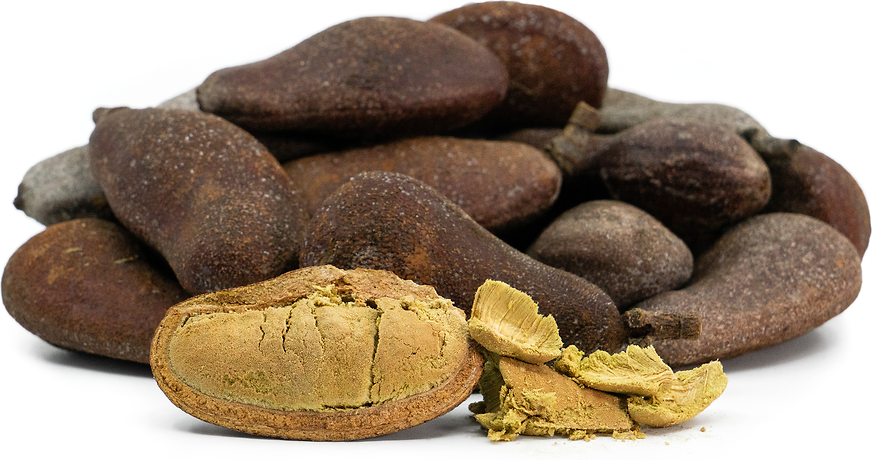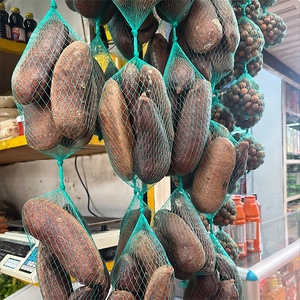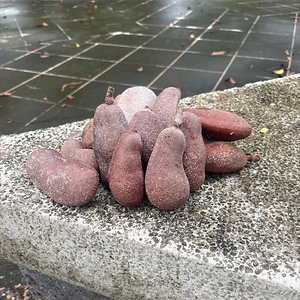


Stinking Toe Fruit
Estimated Inventory, ea : 0
Description/Taste
Stinking Toe fruits are small to medium-sized pods averaging 2 to 5 centimeters in diameter and 7 to 13 centimeters in length and have a short and stubby, oblong to kidney-shape with curved ends. Depending on the growing environment, the inedible pods generally weigh 20 to 84 grams and have a tough and textured shell. The pod's protective exterior is hard, fibrous, and woody, about five centimeters thick, and changes in color from green to dark brown or red-brown when mature. Inside the pod are 3 to 6 ellipsoidal, red-brown seeds around 2 to 3 centimeters long. These seeds are inedible and should be discarded. Each seed is enveloped in a powdery, crumbly flesh with a dry, flaky consistency. Most consumers say the flesh has the texture of flour and somewhat coats the entire mouth. Stinking Toe fruits are consumed when ripe and release a pungent, sometimes off-putting aroma when cracked open. The smell is received differently, with some consumers saying it has an unpleasant, sour foot or body odor scent, while others comment that it is only slightly musty. If the fruit does not have a smell, it is often regarded as past its prime or old. Beyond the polarizing scent, Stinking Toe fruits are known for their unusual texture and flavoring. The fruits are said to have a sweet taste reminiscent of vanilla-flavored powdered milk with subtle nuances of parmesan cheese, sugar, black pepper, and herbs.
Seasons/Availability
Stinking Toe fruit is available in the summer.
Current Facts
Stinking Toe fruit, botanically classified as Hymenaea courbaril, is a rare species belonging to the Fabaceae family. The pods grow on large evergreen trees reaching 30 to 45 meters in height, and the species, in general, is one of the tallest trees in South America. Stinking Toe fruits are also known as West Indian Locust, Locust fruit, Jatobá, Jatobazeiro, Courbaril, Brazilian Copal, Amami-Gum, Jatoba, Brazilian Cherry, South American Cherry, Old Man's Toe, Stinktoe, Jamaican Locust Fruit, Jamaican Stinking Toe Fruit, Guapinol, and Koubari. The species may also be labeled by other regional names in various dialects. Throughout history, Stinking Toe fruits have been treasured as a medicinal and culinary ingredient since ancient times and are a delicacy consumed among the indigenous tribes in Central and South America. Stinking Toe fruit trees take 8 to 12 years to bear fruit, but once mature, the trees can produce over 50 kilograms of fruit each season. The fruits earned their odiferous moniker from the pod's curved shape, said to resemble a toe, and the pod's sometimes offensive odor, a scent said to smell like feet. Despite their unusual name, Stinking Toe fruits are a highly valued nutritional source and can be consumed raw or cooked in a variety of culinary preparations.
Nutritional Value
Stinking Toe fruit is a source of fiber to regulate the digestive tract, vitamin C to strengthen the immune system, iron to develop the protein hemoglobin for oxygen transport through the bloodstream, and potassium to balance fluid levels within the body. The flesh also provides calcium to build strong bones and teeth, vitamin A to maintain healthy organ functioning, magnesium to control blood pressure, antioxidants to reduce inflammation and protect the cells against free radical damage, and other nutrients, including phosphorus and zinc. In natural medicines of Central and South America, Stinking Toe fruits have been used as an aphrodisiac and mild laxative. The fruits are also valued for their antibacterial, antimicrobial, and antifungal properties, used to reduce symptoms of illnesses, headaches, and asthma.
Applications
Stinking Toe fruits have a sweet and musky taste suited for fresh and cooked preparations. The pods must be cracked open and are typically hit with a brick, rock, or hammer to break apart. Once opened, the flesh is removed, and the seeds are extracted, leaving only the fine, powdery flesh. Raw Stinking Toe fruit flesh can be consumed straight out of hand and is enjoyed by some, but it has an unusual, dry texture. More often, the fruits are blended into drinks such as smoothies, milkshakes, or cocktails. In Jamaica, the flesh is mixed with sugar, water, and spices to make a refreshing, nutritious drink, while in South America, atole is a beverage made from the flesh, milk, sugar, and water. Stinking Toe fruits dissolve quickly in liquids and add a thicker texture to any mixture it is added to. In addition to beverages, Stinking Toe fruits are made into flour and mixed into crackers, bread, biscuits, and pastries. The flesh can also be made into ice cream or added to soups. Among the Ikpeng people of Brazil, Stinking Toe fruits are mixed into water as a type of porridge or traditionally combined with honey to create a sweet paste. Stinking Toe fruits pair well with spices such as nutmeg, cinnamon, and turmeric, brown sugar, peanuts, pumpkins, potatoes, bananas, vanilla, and condensed milk. Whole, unopened pods will keep for several weeks in a cool and dark place. Once opened, the flesh should be immediately consumed for the best quality and flavor.
Ethnic/Cultural Info
Stinking Toe fruits are spread throughout South America through a unique and somewhat endangered rodent species known as the Agouti. These rodents grow up to 62 centimeters in length and weigh around 4 kilograms and scavenge the rainforest floor for fruits and nuts. Agoutis are the only animal that can crack open the hard-out shell of a Brazil nut using their sharp front teeth. The teeth are also used to crack open the dense, fibrous pods of Stinking Toe fruits. Once the Agoutis break the fruit pods open, seeds and portions of the fruit are consumed. Excess seeds are carried to a specific location and are buried in the ground as a later food source, a process known as "scatter hoarding." Scatter hoarding is also beneficial to the expansion of Stinking Toe Fruits. Agoutis often forget where they buried their food stashes, leaving Stinking Toe fruit seeds in the ground to germinate and sprout. Stinking Toe fruit seeds have spread throughout South America largely in part to animal involvement, and animals, such as the Agouti, play a vital role in the survival of various plant species.
Geography/History
Stinking Toe fruits are a part of Hymenaea courbaril, a species native to tropical and subtropical regions of Central and South America. The species has been growing wild since ancient times, and the seeds were spread naturally through animal and human scattering, leading the trees to expand throughout the Americas and into the Caribbean. Experts believe the species may have its center of origin in the Cerrado Biome, an area in the highlands of Central Brazil that encompasses savannas, grasslands, and forests. Near this biome, Stinking Toe fruits have been extensively used by indigenous populations in Xingu Park, specifically the Ikpeng people, in the southern portion of the Amazon biome. Ikpeng members traditionally used all parts of the tree, including the fruit, for medicinal uses, and warriors would carry the pods on their journeys and eat the flesh as a source of nutrients. Over time, the species was adopted by other communities throughout the Americas. Today Stinking Toe fruits are found in tropical Mexico, the Caribbean, Central America, and South America. The species has also been introduced on a small scale to Southeast and East Asia and specialty growers in Southern California and Florida. When in season, Stinking Toe fruits are primarily sold in their native growing regions through fresh markets. The fruits are also dried and processed into flour, which is packaged and sold through online retailers worldwide as a nutritional supplement.
Recipe Ideas
Recipes that include Stinking Toe Fruit. One
| Jamaicans |
|
Stinking Toe Juice |










